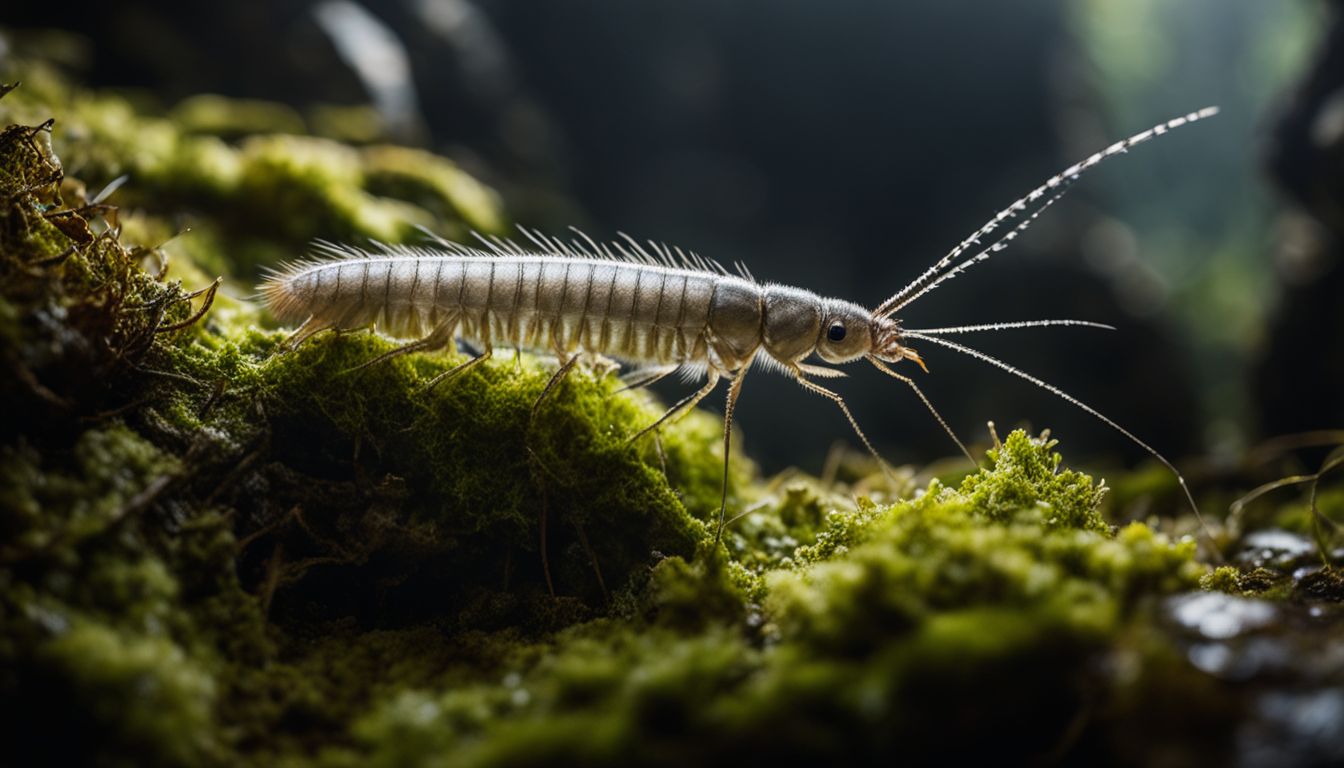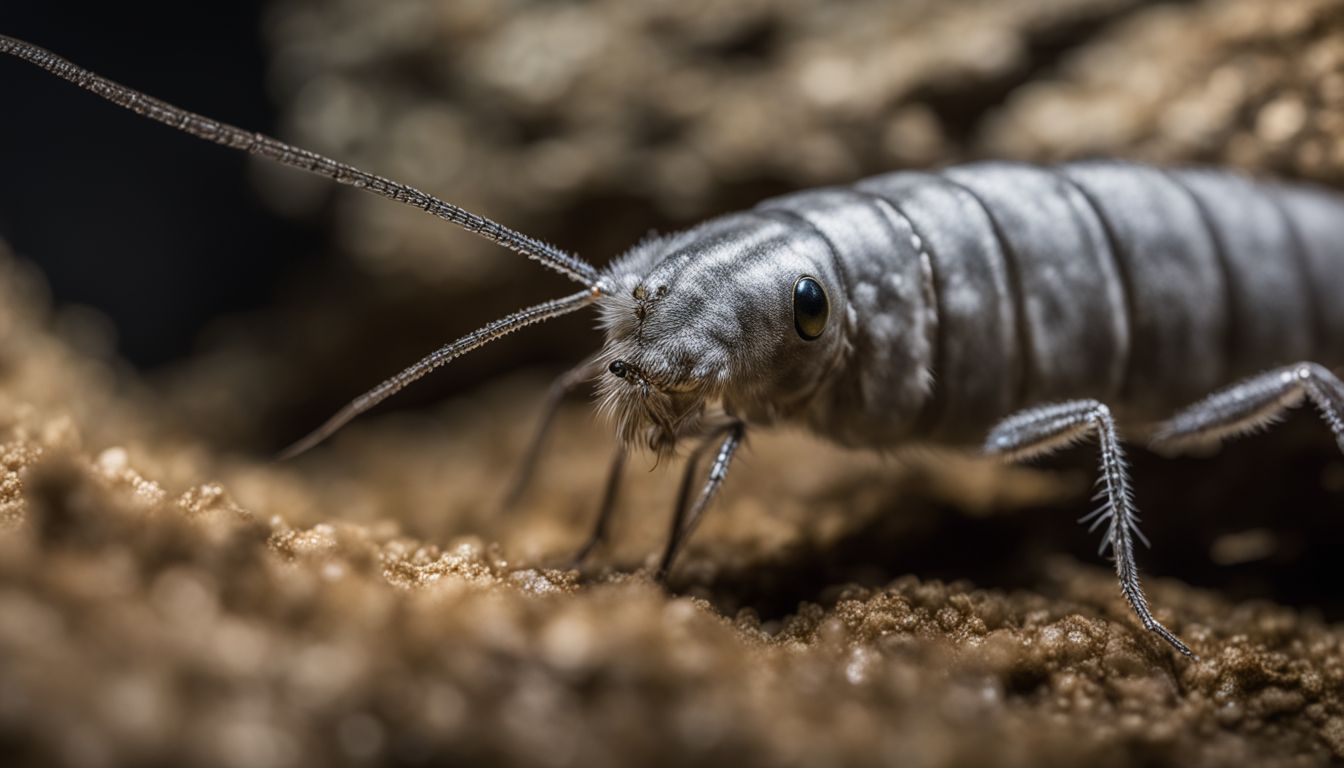“This post contains affiliate links. As an Amazon Associate, I earn from qualifying purchases”
Have you ever noticed a small, silver creature zipping across your bathroom floor or darting behind bookshelves? That’s the silverfish—a tiny insect that’s been scurrying around Earth for over 400 million years.
Many homeowners and tenants find these guests unwelcome, wondering how on earth they move so quickly and seem to pop up everywhere.
Believe it or not, these little critters have been perfecting their movements since the Devonian Period—way before dinosaurs roamed! This article is going to dive into the twists and turns of silverfish evolution.
We’ll explore how changes in their environment pushed them to become the speedy hiders we know (and maybe don’t love) today. And who knows? Understanding their history might just give us insights into keeping them out of our pantries and papers.
Ready for a journey back in time? Keep reading—you’re about to discover some secrets of one of nature’s most ancient pests.
Evolution of Silverfish Movement

Silverfish, those elusive creatures that dart across our bathroom floors, have refined their movement over millennia—each scurry and regeneration a testament to evolutionary persistence.
Diving into the Devonian period reveals a saga of transformation as these insects adapted their silvery glide to survive in ever-changing habitats.
Agile nature and regeneration abilities
Silverfish can move quickly and twist their bodies. This helps them find food and run from danger, like spiders or house centipedes. If they lose a leg, no problem—they can grow it back! Their quick moves and healing powers have helped them stick around for ages.
As they dash across your bathroom floor, silverfish show off their skills. They zigzag with speed to dodge your footsteps. Even if one gets hurt, it’s not the end of its story. It has the amazing ability to heal itself and get back to darting around in no time!
Early evolution during the Devonian Period
Back in the Devonian Period, life was making a big leap from water to land. Silverfish ancestors were part of this exciting time. They started out in the ocean but worked their way onto dry ground.
Their bodies and legs changed so they could move around better on land. Instead of swimming, they began to scurry over rocks and dirt.
As these critters adapted to their new home outside of the water, they grew appendages that helped them get around fast and hide from danger. They became nimble and quick – perfect for life on the go in a world full of bigger creatures.
This smart switch-up gave silverfish a good chance at surviving on land long ago.
Changes in appearance
Silverfish have really changed in looks over time. Their bodies got flatter and their legs and antennae longer. These changes help them dart around cracks and crevices better, hiding from us and other threats.
While their scales shimmer like silver, which is where they get their name, it also makes them great at slipping away without being caught.
Their movement made them change how they look too. Think of how athletes build muscles for their sport; silverfish evolved to be fast movers in tight spots because that’s what they needed to survive.
With sleek bodies and squiggly ways of moving, these little creatures are proof that even the smallest animals keep changing with the times.
Theories on Silverfish Movement Evolution

Delving into the realm of silverfish locomotion, we peel back layers of evolutionary mystery. Scientists ponder if a drive to elude human interference or an instinctual adaptation to shifting habitats spurred these insects’ agile advancements.
Prioritizing avoidance of humans
Silverfish are sneaky little bugs. They’ve gotten really good at hiding from us over time. When we moved into more places, these insects had to change their ways. Now they zip around quickly and stay away from areas where humans hang out.
This means fewer chances for us to see them or catch them.
They have a special sense for picking up on our smell too. So when they smell people nearby, they’re off in a flash! Because of this, silverfish can live in our homes without us even knowing it.
They avoid danger by being super careful about where they go and how fast they get there.
Environmental changes and adaptations
Our world is always changing. Weather gets warmer or cooler, and new buildings go up. Silverfish have to keep up with these changes to survive. They are good at finding new ways to move so they can live in many places.
These little insects have changed a lot over time because the earth has changed.
Silverfish have become very good at hiding and running fast to stay safe from danger, like people who might not want them around their homes. They can slip into tiny cracks or move quickly across a room without being seen.
Because of this, they’re found in lots of different spots all over the world.
This ability to adjust helps silverfish live through tough situations – whether it’s hot or cold, dry or wet. Next up is how we compare silverfish movement evolution with other bugs that also had to change over time!
Comparison to other insects and their evolution
Silverfish slip through time like shadows, nearly unchanged for hundreds of millions of years. Many insects have wild life cycles with big changes, like caterpillars turning into butterflies or grubs becoming beetles—this is complete metamorphosis.
These bugs go from egg to larva to pupa and finally to adult, transforming at each step. But not silverfish; they keep it simple.
As tiny copies of adults, they hatch from eggs and grow bigger without reshaping themselves in a cocoon or chrysalis. Like dragonflies and grasshoppers, silverfish show off an older style called hemimetabolan metamorphosis where there’s no dramatic change-up—just young ones maturing slowly into grown-ups.
Their ancient dance avoids the spotlight that so many other insects bask in during their complex transformations through various life stages.
Conclusion
So, what did we learn? Silverfish have been changing for millions of years. They’ve gotten really good at moving fast and squeezing into tiny spots. These changes help them avoid danger and find snacks to munch on.
This tells us that even little bugs keep adapting, just like bigger animals. And by looking at how they move, we can come up with better ways to deal with pests or even make new robots!
FAQs
1. What are silverfish and where do they come from?
Silverfish, or Lepisma saccharina, belong to the Zygentoma order. They’re ancient bugs that have been around for quite a while—think of them like your home’s unwanted guests.
2. Have silverfish always moved the same way?
Nope—they’ve changed over time! As some insects evolved, they started metamorphosing during their life cycles—a bit like how caterpillars turn into butterflies—but not silverfish. They keep it simple, changing just a little as they grow but never going through a pupal stage.
3. Do all insects change in the same way as silverfish?
Not at all! Insects like cockroaches and earwigs also skip the whole pupal scene, but others enter what’s called holometaboly, totally transforming themselves. Imagine having wings one day when you didn’t before—that’s how big a deal it is for some bugs!
4. Why don’t silverfish change much as they get bigger?
It’s because of something called juvenile hormone (JH). It’s kind of like an insect’s guide—it helps them know when to stay young and when to become adults without needing any fancy changes.
5. Are there different kinds of these wriggly critters?
You bet! While urban silverfish scurry around our homes munching on starches, other species like jumping bristletails enjoy life away from human pads in more natural spots outdoors.
6.Does science tell us anything cool about these no-change champs?
Absolutely! Science digs deep into genes and proteins to figure out why these creatures stick to their tried-and-true ways instead of switching things up big-time during development.